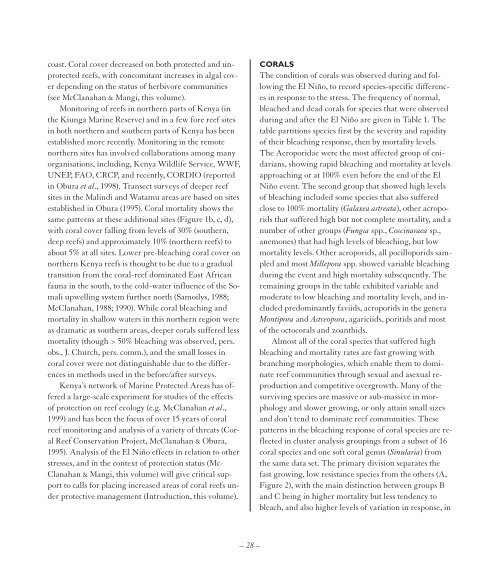Create successful ePaper yourself
Turn your PDF publications into a flip-book with our unique Google optimized e-Paper software.
coast. Coral cover decreased on both protected and unprotected<br />
reefs, with concomitant increases in algal cover<br />
depending on the status of herbivore communities<br />
(see McClanahan & Mangi, this volume).<br />
Monitoring of reefs in northern parts of Kenya (in<br />
the Kiunga Marine Reserve) and in a few fore reef sites<br />
in both northern and southern parts of Kenya has been<br />
established more recently. Monitoring in the remote<br />
northern sites has involved collaborations among many<br />
organisations, including, Kenya Wildlife Service, WWF,<br />
UNEP, FAO, CRCP, and recently, <strong>CORDIO</strong> (reported<br />
in Obura et al., 1998). Transect surveys of deeper reef<br />
sites in the Malindi and Watamu areas are based on sites<br />
established in Obura (1995). Coral mortality shows the<br />
same patterns at these additional sites (Figure 1b, c, d),<br />
with coral cover falling from levels of 30% (southern,<br />
deep reefs) and approximately 10% (northern reefs) to<br />
about 5% at all sites. Lower pre-bleaching coral cover on<br />
northern Kenya reefs is thought to be due to a gradual<br />
transition from the coral-reef dominated East African<br />
fauna in the south, to the cold-water influence of the Somali<br />
upwelling system further north (Samoilys, 1988;<br />
McClanahan, 1988; 1990). While coral bleaching and<br />
mortality in shallow waters in this northern region were<br />
as dramatic as southern areas, deeper corals suffered less<br />
mortality (though > 50% bleaching was observed, pers.<br />
obs., J. Church, pers. comm.), and the small losses in<br />
coral cover were not distinguishable due to the differences<br />
in methods used in the before/after surveys.<br />
Kenya’s network of Marine Protected Areas has offered<br />
a large-scale experiment for studies of the effects<br />
of protection on reef ecology (e.g. McClanahan et al.,<br />
1999) and has been the focus of over 15 years of coral<br />
reef monitoring and analysis of a variety of threats (Coral<br />
Reef Conservation Project, McClanahan & Obura,<br />
1995). Analysis of the El Niño effects in relation to other<br />
stresses, and in the context of protection status (Mc-<br />
Clanahan & Mangi, this volume) will give critical support<br />
to calls for placing increased areas of coral reefs under<br />
protective management (Introduction, this volume).<br />
CORALS<br />
The condition of corals was observed during and following<br />
the El Niño, to record species-specific differences<br />
in response to the stress. The frequency of normal,<br />
bleached and dead corals for species that were observed<br />
during and after the El Niño are given in Table 1. The<br />
table partitions species first by the severity and rapidity<br />
of their bleaching response, then by mortality levels.<br />
The Acroporidae were the most affected group of cnidarians,<br />
showing rapid bleaching and mortality at levels<br />
approaching or at 100% even before the end of the El<br />
Niño event. The second group that showed high levels<br />
of bleaching included some species that also suffered<br />
close to 100% mortality (Galaxea astreata), other acroporids<br />
that suffered high but not complete mortality, and a<br />
number of other groups (Fungia spp., Coscinaraea sp.,<br />
anemones) that had high levels of bleaching, but low<br />
mortality levels. Other acroporids, all pocilloporids sampled<br />
and most Millepora spp. showed variable bleaching<br />
during the event and high mortality subsequently. The<br />
remaining groups in the table exhibited variable and<br />
moderate to low bleaching and mortality levels, and included<br />
predominantly faviids, acroporids in the genera<br />
Montipora and Astreopora, agariciids, poritids and most<br />
of the octocorals and zoanthids.<br />
Almost all of the coral species that suffered high<br />
bleaching and mortality rates are fast growing with<br />
branching morphologies, which enable them to dominate<br />
reef communities through sexual and asexual reproduction<br />
and competitive overgrowth. Many of the<br />
surviving species are massive or sub-massive in morphology<br />
and slower growing, or only attain small sizes<br />
and don’t tend to dominate reef communities. These<br />
patterns in the bleaching response of coral species are reflected<br />
in cluster analysis groupings from a subset of 16<br />
coral species and one soft coral genus (Sinularia) from<br />
the same data set. The primary division separates the<br />
fast growing, low resistance species from the others (A,<br />
Figure 2), with the main distinction between groups B<br />
and C being in higher mortality but less tendency to<br />
bleach, and also higher levels of variation in response, in<br />
– 28 –


















